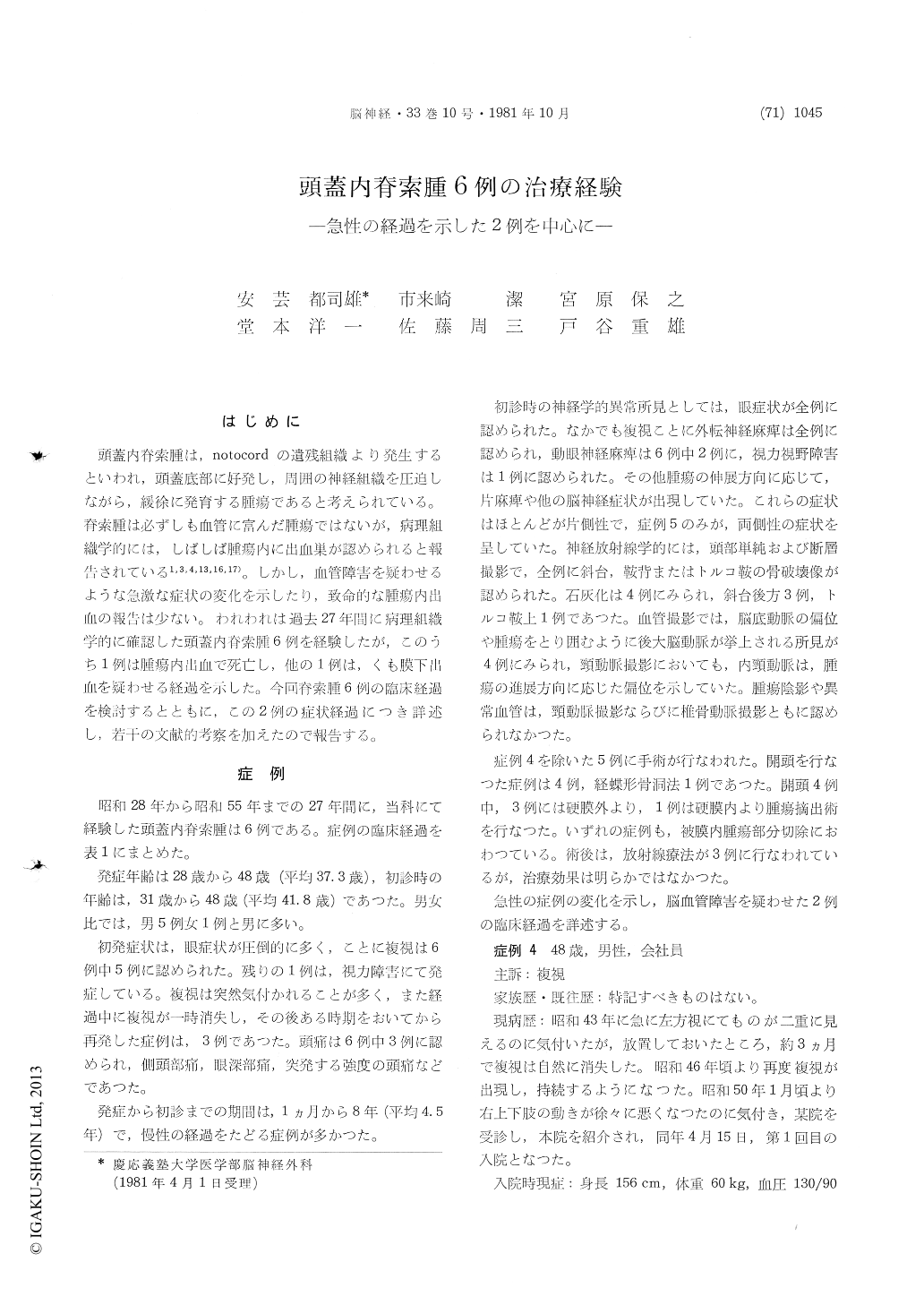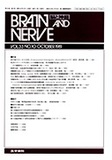Japanese
English
- 有料閲覧
- Abstract 文献概要
- 1ページ目 Look Inside
はじめに
頭蓋内脊索腫は,notocordの遺残組織より発生するといわれ,頭蓋底部に好発し,周囲の神経組織を圧迫しながら,緩徐に発育する腫瘍であると考えられている。脊索腫は必ずしも血管に富んだ腫瘍ではないが,病理組織学的には,しばしば腫瘍内に出血巣が認められると報告されている1,3,4,13,16,17)。しかし,血管障害を疑わせるような急激な症状の変化を示したり,致命的な腫瘍内出血の報告は少ない。われわれは過去27年間に病理組織学的に確認した頭蓋内脊索腫6例を経験したが,このうち1例は腫瘍内出血で死亡し,他の1例は,くも膜下出血を疑わせる経過を示した。今回脊索腫6例の臨床経過を検討するとともに,この2例の症状経過につき詳述し,若干の文献的考察を加えたので報告する。
Six patients (five men and one woman) with in-tracranial chordoma were treated at Keio Univer-sity hospital for the past 27 years. They accounted for 0.4% of the total number of patients with intracranial tumor. The mean age of the patients when they contracted chordoma was 37.7 years, and the mean period from onset to their first visit to the hospital was 4.5 years. The major symptom was diplopia, which was observed in 5 of them. At the initial examination, abducens paralysis was observed neurologically in all of the pateints. Other neurological symptoms were observed along with advancement of the tumor. Neuroradiologically, skull roentgenogram and skull tomogram revealed bone destruction of the clivus, dorsum sellae, and sella turcica. Angiograms did not reveal tumor stains and/or abnormal vessels. Operations were performed by the intracranial approach in four of the patients and by the transsphenoidal approach in one, however, the tumor was only partially ex-cised in each case.
Chordoma is usually chronic, but two of the patients showed acute changes in symptoms. One of the patients was a 48-year-old man. Seven years ago, the patient experienced diplopia, which disap-peared 3 months later. Four years ago, diplopia appeared again. When right hemiparesis occurred 3 months ago, the patient was admitted to our hospital. Neurologically, abduction disorder of the left eye, nystagmus, and right hemiparesis were observed. Since the patient did not agree to an operation, he was discharged. Thereafter, he was treated as an outpatient. However, severe headache and disturbance of consciousness occurred suddenly, and was readmitted to our hospital. He went into a coma and died without coming out of the coma. At autopsy, a hemorrhagic tumor was noted on the ventral surface of the pons. Histologically, the tumor was chordoma.
The other patient who showed acute changes was a 48-year-old woman. She had headache slightly one day. When she got up on the next morning, her headache worsened and she experienced diplopia and right ptosis. While being examined at a neighboring hospital, she lost consciousness. After she regained consciousness, she complained of severe headache. She was admitted to our hospital about50 days later. At admission, bilateral abducens paralysis and right ptosis gradually improved and ptosis disappeared. A transsphenoidal surgery was performed, and the patient was diagnosed as having chordoma.
In both cases, neither aneurysm nor arteriovenous malformation was observed angiographically or at autopsy.
It is believed that chordoma develops from the remnants of the notochord and progresses slowly. Furthermore, angiograms rarely reveal tumor stains, suggesting that chordoma does not always contain a large number of vessels. On the other hand, it is often reported that hemorrhagic necrosis is ob-served histologically in chordoma. However, there are few roports of the relationships between chor-doma, acute changes in symptoms which possibly result in vascular disorders are occasionally ob-served. Hemorrhage in the tumor can be considered as of the mechanisms involved in the occurence of these changes. Since these changes seem to be very significant in the diagnosis and treatment of chordoma, they are reported here along with a discussion based on the literature.

Copyright © 1981, Igaku-Shoin Ltd. All rights reserved.


